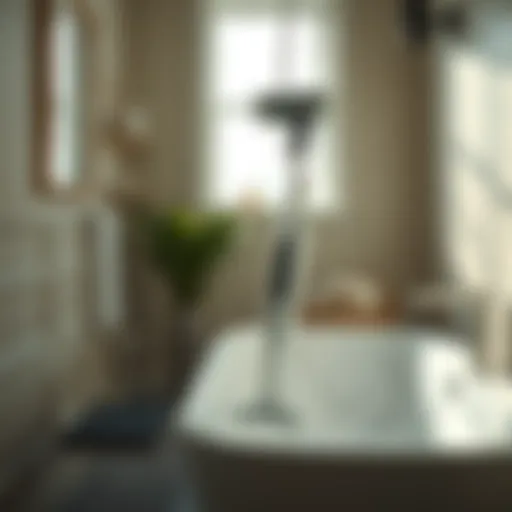Exploring the Terrazzo Bathroom Floor: A Comprehensive Guide
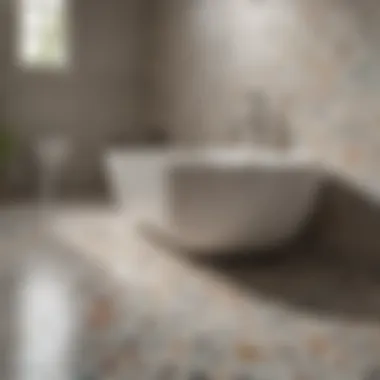

Intro
The revival of terrazzo flooring in bathrooms is gaining attention. This material, rich in history and innovation, offers unique aesthetic appeal while providing durability. Terrazzo was originally created in Venice, Italy, but has evolved over the decades. It's made from chips of marble, glass, or other materials, set in a cement or resin base. This composition creates distinct patterns and colors, ideal for various design themes.
Understanding the benefits of terrazzo is essential. Not only is it sustainable due to the use of recycled materials, but it also allows for creativity in design. From traditional to modern looks, terrazzo adapts well and uplifts the overall bathroom vibe.
As homeowners explore options for bathroom remodels, it is imperative to consider factors like installation, maintenance, and the long-term performance of terrazzo. This guide will delve into the process, design inspirations, and practical aspects of incorporating terrazzo into bathroom spaces.
Design Inspirations
When selecting terrazzo flooring, design inspirations play a significant role. The variety of styles and color possibilities can significantly influence the mood and function of the bathroom. Each element of design contributes to the final aesthetic.
Trending Styles
Terrazzo is not confined to a single style. It bridges the gap between traditional and contemporary designs. The following are some trending styles:
- Minimalist: Simple, clean lines prevail, focusing on subtle variations in color.
- Vintage: Incorporating retro color schemes and larger chips can reminisce classic designs.
- Eclectic: Mixing various materials and styles creates a lively atmosphere. Multiple colors can be used to make striking patterns.
Focusing on one style can help narrow down choices, ensuring coherence throughout the bathroom.
Color Palettes
The color of terrazzo tiles largely determines the ambiance. Here are some popular color palettes:
- Neutral Tones: Creams, taupes, and soft grays create a calm environment.
- Earthy Hues: Warm greens, ochres, and browns instill a connection to nature.
- Bold Contrasts: Using vibrant colors like deep blue or red can add a dramatic effect, perfect for modern spaces.
Choosing a color that aligns with personal tastes and existing décor is important.
Terrazzo not only enhances the value of a home but also stands as a hallmark of sustainable design.
Product Recommendations
To complement terrazzo flooring, specific bath accessories and essentials can enhance the overall aesthetic while providing functionality.
Bath Accessories
Selecting the right accessories can unify the space. Consider:
- Vanity Units: A sleek vanity complements the terrazzo's design.
- Shower Fixtures: Choose fixtures that match the elegance of terrazzo.
- Storage Solutions: Elegant baskets or drawers can keep the bathroom organized while looking good.
Bedroom Essentials
The adjoining bedroom should also echo the same design ethos:
- Rug Choices: Soft, neutral rugs can soften the transition from terrazzo floors.
- Textiles: Choose textiles that enhance the color scheme of the bathroom.
- Artwork: Incorporate wall art that utilizes similar color palettes for cohesion.
Intro to Terrazzo Flooring
Terrazzo flooring has gained significant popularity in recent years, especially in bathrooms. This type of flooring combines aesthetics and functionality, offering a unique option for both modern and traditional interiors. In this section, we will explore what terrazzo is and how it can enhance your bathroom's design.
Definition and Composition
Terrazzo originated in Italy as a way to reuse waste marble chips. The composition typically includes a mixture of chips made from marble, quartz, glass, or other materials, embedded in a cement or epoxy resin. This makes terrazzo not only visually appealing but also durable. The finish can come in glossy or matte forms, depending on personal preference.
Understanding its composition is crucial. Terrazzo's versatility in color and texture allows homeowners to customize their floors to match their unique style. The ability to mix different materials means each installation can have its own character.
Historical Background
The history of terrazzo dates back to the 15th century. It was first developed in Venice by workers who sought to make use of leftover marble scraps. They created a durable flooring solution that could withstand the wear and tear of everyday life. Over the centuries, its use spread across Europe and eventually around the world.
In the mid-20th century, terrazzo saw a resurgence in popularity, particularly in commercial spaces. Its practical qualities made it a favored flooring choice in hotels, airports, and public buildings. Today, it has transitioned into residential spaces, particularly in bathrooms, where its blend of beauty and resistance to moisture and stains make it an ideal option.
Terrazzo offers an exciting balance of tradition and modern functionality, catering to both aesthetic desires and practical needs.
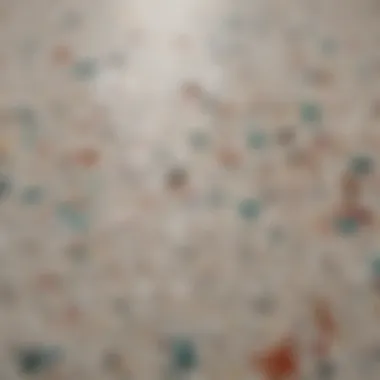

Advantages of Terrazzo in Bathrooms
Terrazzo flooring in bathrooms offers a plethora of advantages, making it a compelling choice for homeowners. Its practical benefits and aesthetic appeal create a strong case for its use in personal spaces. Whether you prioritize durability, low maintenance, or design flexibility, terrazzo has unique features that stand out.
Durability and Low Maintenance
One of the most notable benefits of terrazzo flooring is its exceptional durability. This material is composed of chips of marble, quartz, granite, or glass, which are mixed with cement or resin. This combination creates a surface that can withstand heavy foot traffic, making it ideal for bathrooms where moisture and wear are regular occurrences.
The low maintenance of terrazzo is equally appealing. After installation, it requires minimal upkeep. Regular sweeping and mopping with a gentle cleanser are sufficient to keep the surface looking pristine. Unlike other flooring options that can stain easily, terrazzo is more resistant to spills. If a stain does occur, it can often be polished out without significant effort. This characteristic not only saves time but also reduces the stress related to maintaining a clean and appealing bathroom environment.
"Choosing a flooring material that is both durable and easy to maintain can significantly enhance lifestyle quality in a busy household."
Aesthetic Versatility
Terrazzo shines in terms of aesthetic versatility. It comes in an array of colors, patterns, and finishes, allowing homeowners to customize their bathroom floors to match personal style. This design flexibility is advantageous, especially in creating unique looks that differentiate a space.
Homeowners can select contrasting colors to create a bold statement or opt for subtle hues that offer a serene ambiance. Terrazzo’s ability to be customized means it can integrate seamlessly into various design styles—from minimalist to maximalist, traditional to contemporary. This adaptability is crucial for those looking to reflect their personal tastes in home decor without sacrificing quality.
The integration of terrazzo with other materials, such as wood or metal fixtures, further enhances its design appeal. This flooring can complement a variety of textures and finishes while providing a cohesive look within the bathroom.
In summary, terrazzo flooring presents significant advantages for bathrooms. Its durability and low maintenance appeal to practicality, while its aesthetic versatility allows for personal expression. Together, these factors make terrazzo a valuable choice in modern interior design.
Design Possibilities with Terrazzo
The design possibilities with terrazzo are extensive, making it a compelling choice for bathroom flooring. Terrazzo is not just about functionality; its aesthetic appeal enhances the overall vibe of a bathroom. Homeowners can create unique environments through the careful selection of colors and patterns, elevating the space's visual impact.
Color and Pattern Customization
Color and pattern customization is one of the standout features of terrazzo flooring. Homeowners can choose from a wide spectrum of colors that range from subtle neutrals to vibrant hues. This allows the floor to become a statement piece or blend harmoniously with existing decor. Each batch of terrazzo can be composed of various aggregates, including marble, glass, or other materials. This not only influences the color but also adds texture and depth.
The customization extends to patterns as well. Homeowners can opt for simple speckles for a modern look or elaborate designs for a more traditional feel. The ability to personalize the floor ensures that it reflects the homeowner’s individual taste and complements their overall design theme.
"Terrazzo flooring opens up a realm of creative expression that few other materials can offer."
Integration with Other Materials
Integrating terrazzo with other materials can further enhance its aesthetic value. When combined with wood or metal accents, for example, terrazzo can achieve a striking contrast that adds dimension to the space. The smooth finish of terrazzo pairs beautifully with the warm textures of wood, creating a balanced and inviting atmosphere.
Moreover, terrazzo can seamlessly integrate with fixtures and cabinetry in bathrooms. One can coordinate colors and patterns through the selection of sink basins, countertops, and cabinetry materials. This thoughtful integration creates a cohesive design that draws the eye and makes the space appear more sophisticated.
Using terrazzo alongside environmental elements, such as plants or natural stone walls, also helps ground the space. Such combinations not only uplift the design but also contribute to a calming effect in the bathroom.
By exploring these design possibilities, homeowners can harness the unique attributes of terrazzo to create personalized spaces that are both functional and visually appealing.
Sustainability Aspects of Terrazzo
The importance of sustainability in today's design choices cannot be overstated. As homeowners and designers look for environmentally friendly materials, terrazzo flooring emerges as a commendable choice. This section delves deeper into the sustainability aspects of terrazzo, highlighting its source of materials and longevity, which significantly affect its environmental impact.
Source of Materials
Terrazzo flooring is made primarily from recycled materials. The aggregates used in terrazzo can include various forms of recyclable items such as glass, marble, and quartz. By utilizing recycled content, terrazzo minimizes waste and helps reduce the demand for new materials. This not only diminishes the carbon footprint but also encourages a circular economy.
Manufacturers sourcing these materials contribute to sustainable practices. For instance, using post-consumer glass not only repurposes waste but also introduces unique colors and textures to the flooring. An added advantage is that local sourcing can reduce transportation emissions, further enhancing its sustainability narrative. Additionally, the blend of natural materials ensures that the flooring remains aesthetically pleasing without sacrificing environmental responsibility.
Longevity and Environmental Impact
The longevity of terrazzo flooring is another pivotal aspect of its sustainability. Terrazzo is highly durable and can last for decades with proper maintenance. This minimizes the need for replacement, which is a significant contributor to waste in the construction industry. In essence, the longer a flooring option lasts, the less frequently it needs to be replaced, ultimately supporting sustainability.
When considering the environmental impact, terrazzo has a favorable profile. Its ability to withstand wear and tear means fewer resources are consumed over time. Moreover, terrazzo does not release harmful substances into the environment during its lifecycle. Its seamless nature helps reduce the accumulation of dirt and allergens, contributing to better indoor air quality.
"Choosing terrazzo is not just a decision for beauty; it's an investment in sustainability."
Installation Process of Terrazzo Flooring
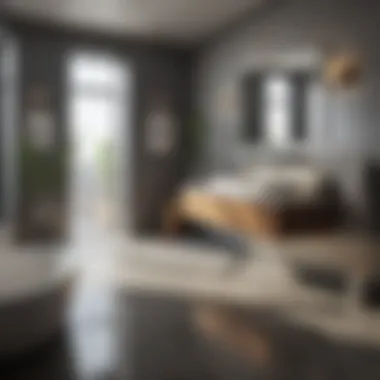

The installation process of terrazzo flooring is critical to the overall success and longevity of the surface. A well-executed installation ensures that the floor remains durable and aesthetically pleasing for many years. This part of the article will discuss the necessary steps for installation, including preparation, technique for laying the tiles, and the all-important finishing touches that complete the look. Proper installation also prevents common issues such as cracking or uneven surfaces that may arise from improper techniques or a rushed job.
Preparation and Planning
Before any terrazzo flooring can be laid, careful preparation and planning are essential. This stage lays the groundwork for successful installation. House owners must measure the bathroom space accurately, keeping in mind the dimensions and layout.
Here are key points to consider during the preparation phase:
- Assess the Subfloor: Check if the subfloor is level, clean, and dry. Any irregularities might require leveling compounds.
- Choose the Right Materials: The type of aggregate and resin affects appearance and performance. Selecting high-quality materials ensures durability.
- Sample Designs: It's wise to create samples of proposed colors and patterns to visualize the final look.
Thorough preparation reduces potential complications during and after installation. Taking the time to plan effectively contributes significantly to the overall success of the project.
The Laying Technique
The technique used in laying terrazzo flooring involves specific methods that should be adhered to for the best results. Start with a proper mix of resin, cement, and aggregates to ensure good bonding and strength. The laying process generally involves the following steps:
- Apply the Base Layer: A base layer of cement or polymer-resin acts as a binder for the aggregates.
- Spread the Terrazzo Mix: Evenly distribute the terrazzo mixture over the prepared subfloor. This step requires attention to detail to ensure flatness.
- Troweling: After spreading, a trowel is used to compact the mixture. This is crucial for achieving a smooth finish.
- Curing: Allow the floor to cure adequately. Curing typically takes several days, during which the surface should remain undisturbed.
Using specialized tools may be necessary, such as mixers for the terrazzo mixture and polishing equipment for the finish.
Finishing Touches
Once the terrazzo is laid and cured, it is time for the finishing touches. This final stage is vital for achieving the desired appearance and prolonging the lifespan of the floor. Here are the main tasks:
- Polishing: Polishing the cured surface brings out the visual appeal of the aggregates and creates a high-gloss finish.
- Sealing: A quality sealer protects the terrazzo from stains and damage, extending its life and maintaining its beauty.
- Cleaning: Thorough cleaning is needed to remove any debris or dust generated during installation.
Finishing touches define the final look of terrazzo flooring and impact its long-term maintenance.
In summary, the installation of terrazzo flooring is a multi-step process that requires attention to detail from preparation through to the finishing touches. Following each step meticulously will result in a beautiful and durable floor that can enhance any bathroom space.
Maintenance of Terrazzo Bathroom Floors
Proper maintenance of terrazzo bathroom floors is crucial for preserving their aesthetic appeal and structural integrity. Terrazzo, known for its durability and timeless elegance, still requires regular upkeep to ensure it remains in optimum condition. Homeowners should not overlook this aspect when choosing terrazzo, as neglect can lead to more significant issues in the long run. The value of terrazzo flooring is not only in its initial installation but also in its long-term performance and upkeep.
Routine Cleaning Practices
To keep terrazzo looking pristine, routine cleaning is essential. Regular maintenance can prevent dirt and grime build-up, which can dull the surface over time. Here are some key practices:
- Sweep or Dust: Use a soft broom or a vacuum with a non-beater bar to remove loose dirt and debris regularly. This prevents scratches that can occur from grit being ground into the floor.
- Mopping: For deep cleaning, use a mop dampened with a pH-neutral cleaner. Avoid harsh chemicals that can damage the surface of the terrazzo.
- Drying: After cleaning, it’s good practice to dry the floor with a soft cloth to minimize water spots and streaks.
In addition to these steps, consider using mats at entrances to reduce the amount of dirt brought into the bathroom. This small adjustment can significantly extend the life of your flooring.
Addressing Stains and Scratches
Even with diligent cleaning, stains and scratches may occur. Knowing how to deal with these will help maintain the beauty of your terrazzo. When encountering a stain, first identify the type of stain you are dealing with, as this will determine the appropriate treatment. Here are some general tips for addressing common stains:
- Oil-Based Stains: These can often be treated with a mix of baking soda and water to create a paste. Apply it to the stain and let it sit for about 30 minutes before rinsing away.
- Organic Stains (like food or drinks): A gentle cleaner might suffice. Apply it to the stain following the product instructions closely.
Scratches can be more challenging to fix. Minor scratches may be polished out by using a fine abrasive pad followed by a polishing compound specifically designed for terrazzo. It is advisable to consult with a professional if the scratches are deep or widespread.
For significant repairs, always consider hiring professionals familiar with terrazzo restoration.
Proper maintenance through regular cleaning and prompt stain and scratch management ensures that your terrazzo bathroom floors not only look stunning but also last for years to come.
Cost Considerations for Terrazzo Flooring
Understanding the cost considerations for terrazzo flooring is crucial for homeowners contemplating this aesthetic choice. Terrazzo offers both beauty and durability, but it is essential to analyze the financial implications surrounding its installation and upkeep. Costs can vary widely based on various factors, including materials, design complexity, and installation processes. Evaluating these elements can significantly affect budgeting decisions. Knowing the potential return on investment can also guide the decision-making process.
Initial Investment and Budgeting
The initial investment for terrazzo flooring can be higher than other flooring options. It typically encompasses costs related to materials, labor, and installation.
- Materials: Terrazzo consists of a mix of aggregates, which can include marble, glass, or other types of stone. The choice of these materials directly influences the overall cost. Some aggregates are more expensive than others, thus affecting total expenses.
- Labor: The labor cost for installation can significantly vary due to the level of skill required. Talented artisans who specialize in terrazzo installations usually charge higher rates. It is important to evaluate multiple quotations before committing.
- Installation: Depending on the complexity of the design, the installation time may be extended. Customized patterns or intricate designs will increase the upfront costs.
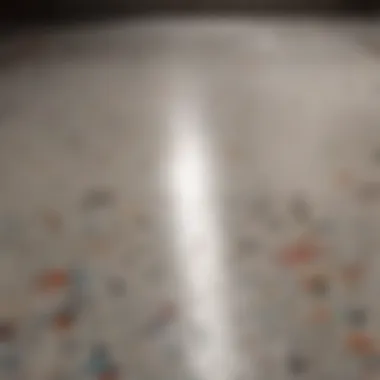

Here are some guidelines for budgeting:
- Research various materials to find a balance between cost and aesthetics.
- Obtain multiple quotes from qualified contractors to ensure a competitive price.
- Factor in additional costs such as potentially required underlayment or preparatory work based on your existing floor condition.
Long-Term Value and ROI
The long-term value of terrazzo flooring often offsets the initial investment and budgeting concerns. When evaluating ROI, there are several factors to consider:
- Durability: Terrazzo flooring is known for its strength and resistance to wear. It lasts for decades with proper maintenance, making it a cost-effective choice over time. This longevity can reduce replacement costs that can arise with other flooring types.
- Energy Efficiency: Terrazzo naturally has thermal properties. Some designs can help maintain temperatures, potentially lowering heating and cooling costs in the long term.
- Value Addition: Investing in terrazzo floor may increase property value. Unique and high-end materials often enhance the allure of a home, leading to better market appeal. When selling your home, this could translate into a higher selling price.
"Investing in quality materials like terrazzo flooring not only transforms a space but can also secure a more substantial return when it’s time to sell."
Comparison with Other Bathroom Flooring Options
When considering the best flooring for bathrooms, it is critical to compare terrazzo with other available options. Each flooring type holds distinct features and practical benefits that cater to different needs. Evaluating these alternatives allows homeowners to make informed decisions suited to their personal style, maintenance preferences, and budget.
Ceramic and Porcelain Tiles
Ceramic and porcelain tiles are commonly preferred choices for bathroom flooring. They are non-porous and highly resistant to moisture, making them ideal for wet environments. The main advantages of these tiles include vast design options, ease of cleaning, and affordability. They come in numerous colors and patterns, allowing for creative expression while maintaining durability.
However, ceramic and porcelain tiles can be cold underfoot, which might be uncomfortable without heating. Also, they may chip if heavy objects fall, necessitating careful handling.
"While tiles provide a range of designs, their rigid surface lacks the unique elegance that terrazzo can offer."
Vinyl and Laminate Alternatives
Vinyl and laminate flooring are appealing mainly for their budget-friendliness and ease of installation. These options can imitate natural materials at a fraction of the cost. Vinyl flooring is waterproof, making it suitable for bathrooms, while laminate offers a softer feel underfoot.
Nonetheless, vinyl and laminate are not as durable as terrazzo. They can wear down over time and may require replacement sooner than other materials. Additionally, they lack the unique patterns and textures that terrazzo provides.
Natural Stone Floors
Natural stone floors, such as marble or granite, are synonymous with luxury. They offer natural beauty, uniqueness, and long-lasting durability. Natural stone is also relatively easy to maintain when sealed properly. However, the initial cost can be significantly higher compared to terrazzo. Each stone is unique, giving character to every installation, but it can be more costly to repair or replace damaged sections.
In summary, while comparing terrazzo to other bathroom flooring options, it is evident that each type has pros and cons. Understanding these can guide homeowners in selecting the most suitable flooring that aligns with their needs and aesthetics.
Trends in Terrazzo Flooring
The revival of terrazzo flooring in bathroom design reflects a significant shift in aesthetic preferences and values. As homeowners seek more unique and sustainable materials, terrazzo stands out for its blend of beauty and durability. Understanding these trends is crucial for discerning homeowners who want to create an inviting environment without sacrificing style or longevity.
Emerging Styles and Preferences
In modern aesthetics, terrazzo has taken on various forms. Designers are experimenting with size and color variations, leading to a broader range of styles. Larger chips, for example, add a more contemporary feel to the space, while smaller chips often evoke a more classic look. This flexibility in design allows homeowners to customize their flooring to fit their unique vision.
Colors play a pivotal role in these new styles. Bold, vibrant hues are becoming increasingly popular. Shades of emerald green, deep blue, and even rich reds can transform a bathroom from ordinary to extraordinary. Additionally, pastel colors have found their way into terrazzo designs, appealing to those who prefer subtler tones.
In terms of patterns, geometric designs are gaining traction. By playing with shapes and layouts, it allows for creativity that aligns with modern design principles. Homeowners can select patterns that enhance their existing decor, making their space feel cohesive and thoughtfully curated.
"The versatility of terrazzo allows for endless customization, enabling homeowners to express their style in innovative ways."
Impact of Minimalism and Maximalism
The influence of design movements such as minimalism and maximalism is clear in trends for terrazzo flooring. Minimalism emphasizes clean lines and simplicity. Terrazzo can accomplish this by featuring neutral tones and understated designs that promote tranquility in the bathroom space.
Conversely, maximalism encourages boldness and expression. This movement embraces eclectic design choices, where terrazzo can feature striking colors and complex patterns. It allows homeowners to make a statement, turning floors into a focal point of the bathroom.
Some people combine these views, selecting terrazzo that conveys minimalist styling while still being visually dynamic. This blend often results in a balanced aesthetic. It meets contemporary tastes while nodding to the vibrant history of terrazzo itself.
Overall, the ongoing trends in terrazzo flooring reflect an evolution in design preferences, catering to various tastes while remaining true to its durable nature. Homeowners should consider these trends when planning their bathroom renovations.
End
In the context of this article, the conclusion serves as a reflective summary of the presented insights about terrazzo bathroom flooring. As homeowners and design enthusiasts consider the variety of flooring options, understanding the key features of terrazzo is essential. This carefully crafted material has gained momentum in interior design because of its versatility and durability.
Final Thoughts on Terrazzo in Bathrooms
Terrazzo offers a unique marriage of functional and aesthetic qualities. It can fit various design styles and adapt to different color schemes because of its customizable nature. This makes it a fitting choice for both modern and classic aesthetics. Moreover, it is resilient, which suits the high-traffic environment typical of bathrooms.
Homeowners should consider the maintenance aspects as well. Regular cleaning is straightforward, requiring only basic supplies. The longevity of terrazzo flooring also means that it is an investment that can withstand the wear and tear of daily life. Moreover, the sustainable aspects of terrazzo contribute to a greener building approach. As highlighted throughout the article, the careful consideration of its sources and manufacturing processes makes terrazzo a responsible option.
Ultimately, when planning a bathroom renovation, terrazzo flooring stands out as a compelling option. It harmonizes beauty and practicality, catering to various tastes and needs. The growing popularity and modern design trends reaffirm its place in contemporary homes. Therefore, choosing terrazzo could be a wise enhancement for any bathroom.

